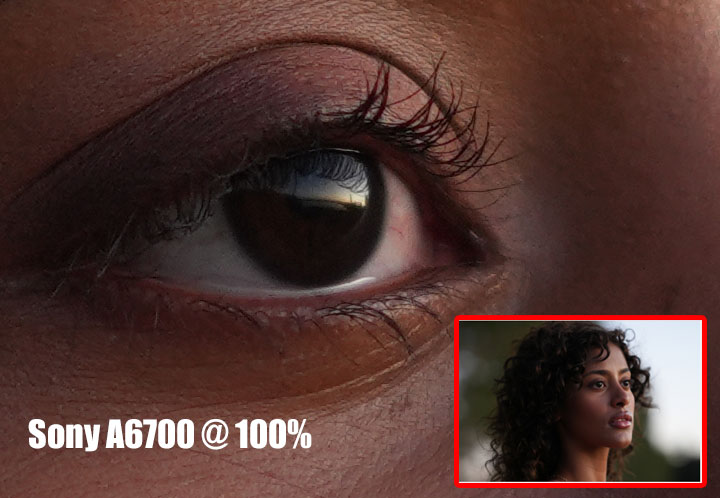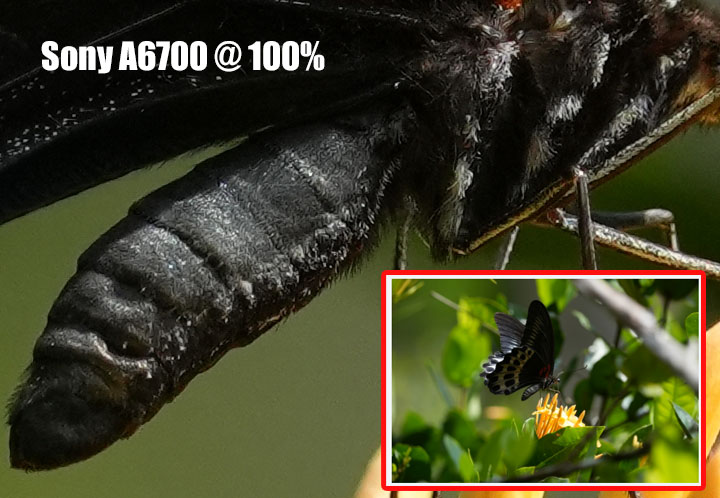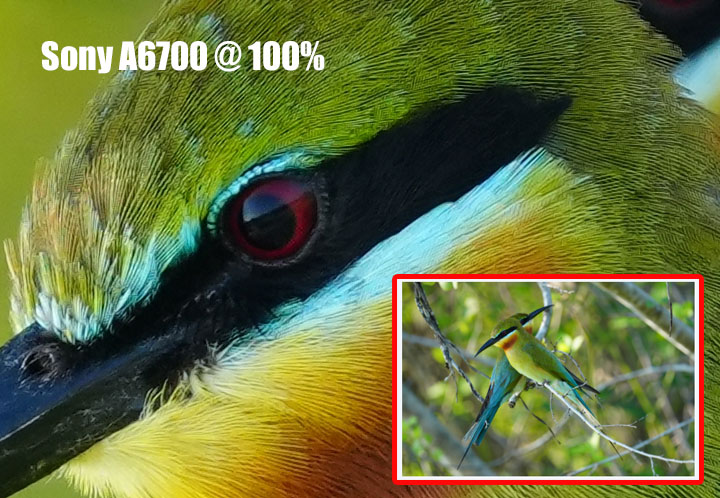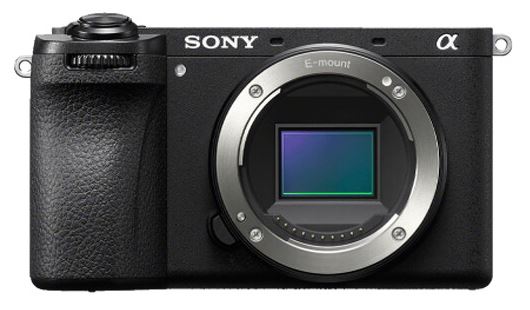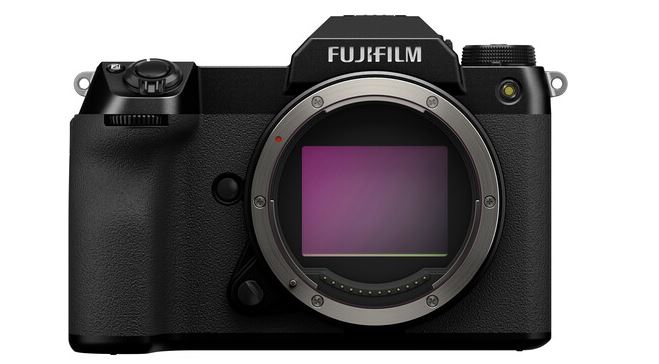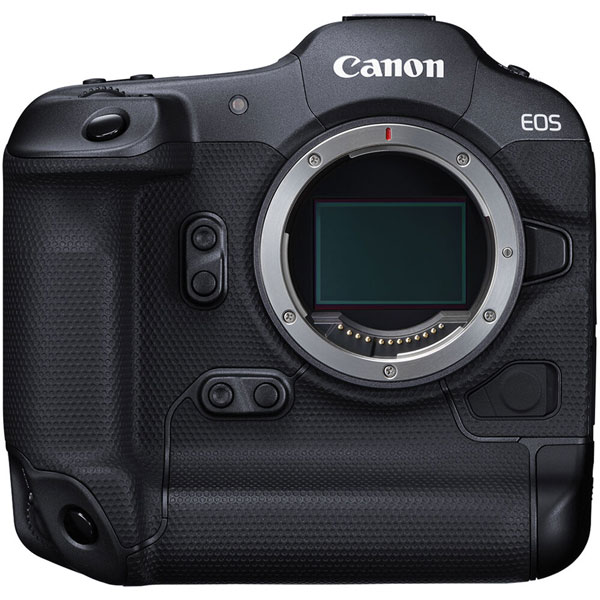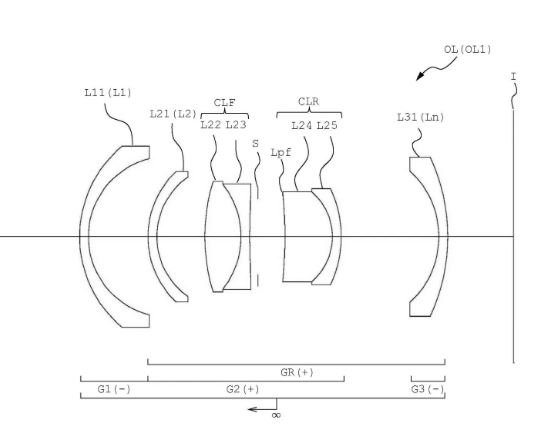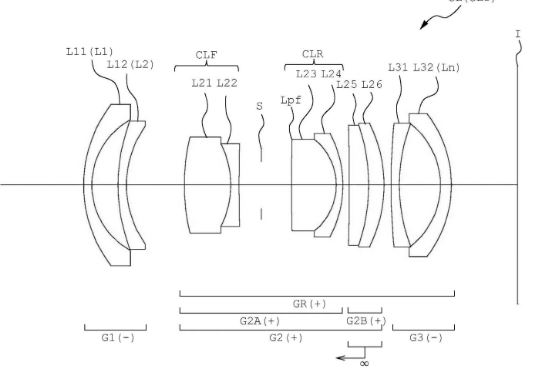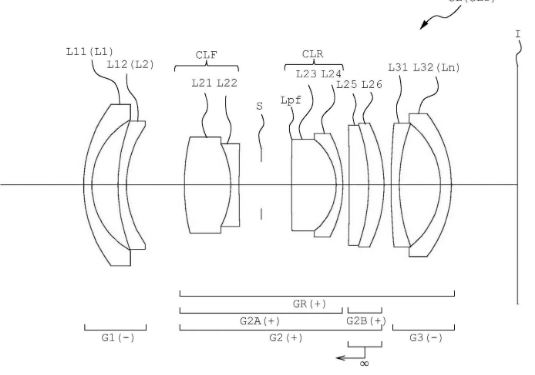
So let’s compare Fuji X S20 camera against the Sony a6700, and find out the best camera for you. Take a look at the detailed specification comparison below.
1. Design Comparison
Overall the weight of the camera is approximately the same, we have only a 3-gram difference in body weight. The design is different as you can notice, Fuji film has a centered viewfinder loaded with more dials and customizable buttons on the top end of the camera.
One additional advantage we have in the Fuji X S20 camera is the presence of a joystick on the rear side of the camera that helps a photographer to jump over the menus or the autofocus points quickly, that is to quickly alter the settings during the shoot. The Sony is weather-sealed so you don’t have to worry while taking it out in outdoor locations.
If you talk about ports then both of them feature a micro HDMI output port, 3.5 mm microphone input port, a 3.5 mm headphone jack, and a USB-C type connection port. The transfer speed of the Sony a6700 camera is 10 Gbps whereas with the Fuji X S20, we are limited to 5 Gbps.
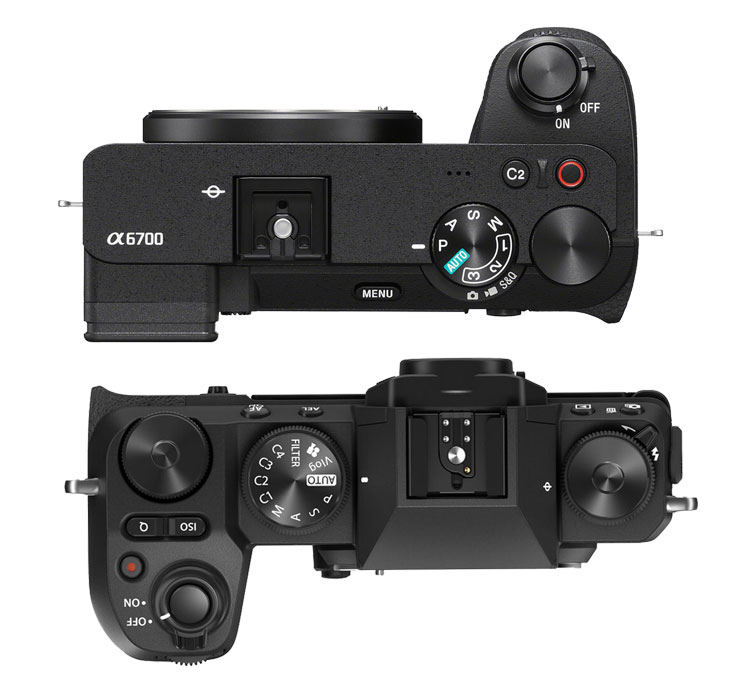
The location of EVF is also a very important thing if you consider it, but it’s completely subjective. On Sony, we have it on the extreme left side, and on Fuji, we have it in the center like we have in traditional DSLRs so it depends if you are already a user of a DSLR or Mirrorless camera that features a viewfinder in the center then you have to think twice before buying the Sony a6700 camera but if you are someone who is completely new then you can start with either Sony or Fuji.
The resolution of the electronic viewfinder of both cameras is exactly the same but the refresh rate of Sony is 120 fps and the higher magnification is 0.70x whereas the refresh rate of Fuji X S20 is 100 fps and magnification of 0.62x, so they are almost identical. None of them have a big difference between them in terms of EVF.
Both cameras feature Vari-angle display screens that can be used for content creation as well as low and high-angle shots but with Fuji, we have a higher resolution screen of 1.84 million dots whereas Sony remains limited to its previous generation displays of 1.04 million dots. The good news is now we have an updated menu in the Sony camera so we don’t have to struggle while setting up our shot.
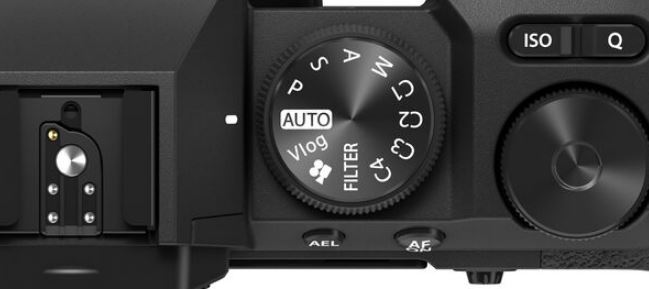
One of the most noticeable things about the Fuji X S20 camera is a dedicated V-Log menu on the top end dial of the camera and when a content creator switches to that menu, the camera opens up a customized menu interface for content creators which is extremely simplified and features product showcase modes.
Both cameras feature a single card slot. Although, for the Sony a6700 camera, you have to use a V90 card to avoid overheating and with the Fuji, since it supports an external fan, you can work with a bit slower card too.
2. The internal core difference between the two cameras
The one has a huge trusted 26-megapixel APS-C sensor of the X-Trans pattern and the other is Sony’s newly developed 26-megapixel CMOS BAYER Pattern sensor. If you are going to compare the two against each other then what we will find is that the Fuji X S20 is able to perform better in low light environments compared to Sony’s a6700 camera.
As you can see, we are comparing the two cameras, Fuji X-T4 against the Fuji X S20 camera. We have picked the X-T4 since the X S20 camera samples are not available yet and as the X-T4 uses the same 26 MP APS-C X-Trans CMOS sensor as of Fuji’s X S20, that’s why we have used it here.
3. IMAGE QUALITY TEST (HIGH ISO vs BASE ISO Test)
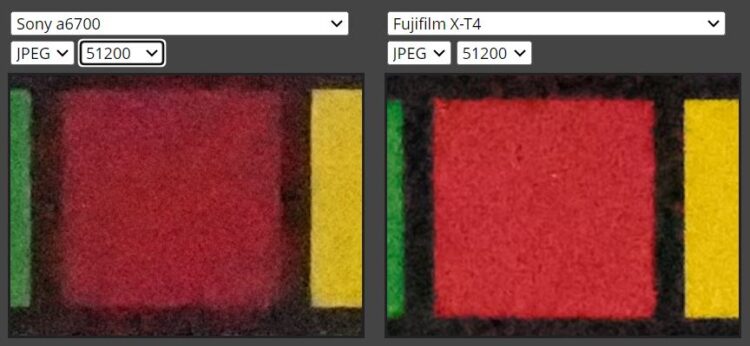
credit dpreview.com
HIGH ISO TEST – (above) clearly visible that the color block of Fuji is well more preserved at ISO 51200 compared to Sony A6700 at ISO 51200. Now if you clearly look at the different sets of image samples captured by both paired with best-of-the-class lenses, you will notice that the Fuji X S20 camera sensor (X-T4 also uses the same 26MP X-Trans sensor) is able to preserve a bit more details when compared to the Fuji X-T4 camera at HIGH ISO TEST.
4. BASE ISO TEST (ISO 100)
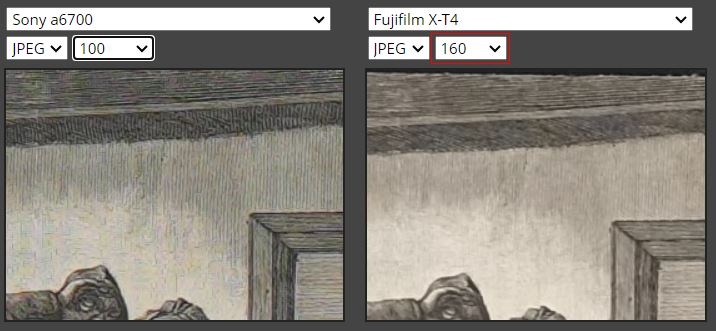
credit dpreview.com
And things become completely wild when you compare the base ISO, then you will find that the Sony a6700 camera is able to capture a bit more detail at several positions of the sample image when compared to the Fuji X S20 camera. Okay, from the tests, it’s obvious that at a higher ISO range, Fuji is better, and at base ISO, possibly the range from 100 to 800 or 1600 ISO, Sony’s new a6700 camera is better.
So from the image quality test, it is very clear that if you are an outdoor photographer or street shooter photographer that does most of his or her work, probably 90% in natural light, then it’s more recommended to buy a Fuji X S20 camera and have better low light performance with 26 MP X-Trans CMOS Sensor. And for those who work in controlled light environments like wedding photographers or portrait shooters who work 90% under controlled light environments, for them, the a6700 is highly recommended based on the initial tests results of both the camera
It’s not recommended to focus on the ISO range of both cameras, as we have already mentioned the higher ISO test. Even though the Sony a6700 has a higher expandable ISO range on paper, it doesn’t perform as well during actual tests. Therefore, it’s better to consider the image samples rather than just the ISO numbers.
| Sony A6700 | FUJIFILM X-S20 | |
| Sensor Resolution | Actual: 27 Megapixel Effective: 26 Megapixel (6192 x 4128) |
Effective: 26.1 Megapixel |
| Image Sensor | 23.3 x 15.5 mm (APS-C) CMOS | 23.5 x 15.6 mm (APS-C) CMOS |
| Crop Factor | 1.5x | 1.5x |
| Image Stabilization | Sensor-Shift, 5-Stops | Sensor-Shift, 7-Stops |
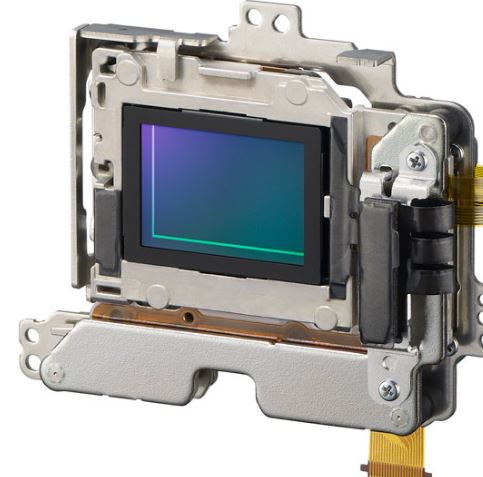
5. IMAGE STABILIZATION (5 Stops vs 7 Stops IBIS)
We have two different image stabilization modes here, one is for stills and the other is for video. For now, let’s begin with the stills part. If you are a photographer, then you will find that the Fuji X S20 camera is able to give you 7 stops of sensor-shift image stabilization feature compared to Sony’s a6700 camera which remains limited to 5 stops of image stabilization. It has been years after the announcement of Sony a6600 camera which also had the same 5 stops of IBIS inside the camera body, so we were hoping for some scaling in the IBIS part of the camera.
In the video, we have gyro-based image stabilization support inside the Sony a6700 camera, so having gyro-based image stabilization in a camera means a lot to a person who is mostly shooting videos @outdoors. And on the other side, we do not have any gyroscopic image stabilization in Fuji. So, if you move too much and create daily content for your channel better to have a camera with gyroscopic data.
Now, one more thing to be noted before we end this discussion is that Sony has introduced a new blur correction feature that works at the pixel level and delivers exceptional-quality of details. And to show that, I have tested it against the Fuji X-T4 camera and a few more. This blur correction algorithm is already running inside the Sony a6700 camera and that’s why possibly your images are able to resolve more details at the base ISO range.
Best AutoFocus – Sony A6700 vs Fuji X-S20
| Sony A6700 | Fuji X-S20 | |
| Focus Type | Auto and Manual Focus | Auto and Manual Focus |
| Focus Mode | Automatic, Continuous-Servo AF, Direct Manual Focus, Manual Focus, Single-Servo AF | Continuous-Servo AF, Manual Focus, Single-Servo AF |
| Autofocus Points | Photo Phase Detection: 759 Video Phase Detection: 495 |
Contrast Detection, Phase Detection: 117 |
6. AUTOFOCUS
The A6700 and X-S20 both have hybrid autofocus systems that use a combination of contrast and phase detection points to focus quickly and accurately. The Sony has 759 phase-detection points that cover 93% of the sensor area, while the Fuji has up to 425 points that cover 99% of the sensor surface. Both cameras are great at recognizing and tracking subjects, including people, animals, birds, insects, and vehicles. Sony goes even further with its dedicated processing chip for deep learning subject detection capabilities, at least in theory.
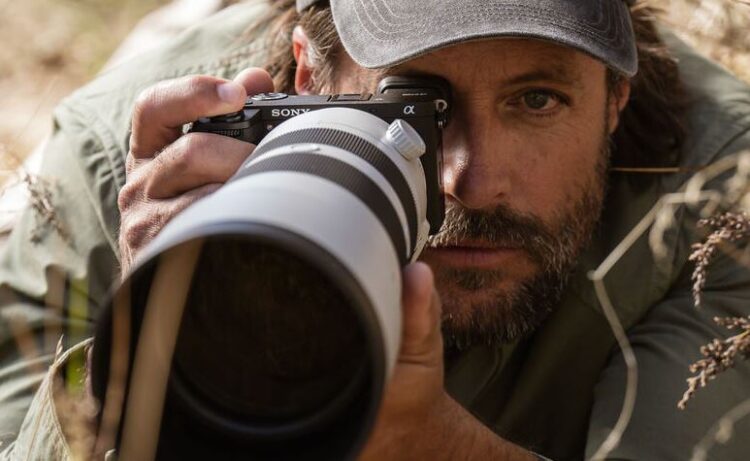
7. AI AF is a Clear Advantage – Sony A6700
Yes, the new AI processor does help with autofocus. It uses a movement prediction algorithm to calculate human body movements and easily track moving subjects, particularly organic movements. This is an improvement over the previous a6600 camera and even its latest competitors, as none of them have an AI chip like Sony in this price range.
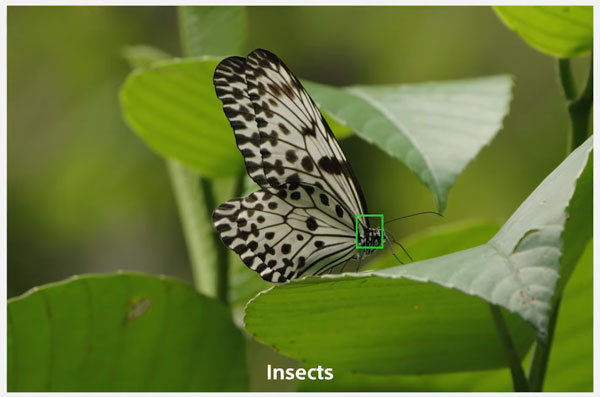
8. Tracking the face of a butterfly – Sony A6700
That’s the biggest advantage that I see in the new update of the chip. The camera is able to track the face of butterflies, insects, as well as moving cars and planes very easily. So that’s the biggest advantage associated with the new AI chip. Although the burst speed is locked, the continuous shooting of the camera is limited to 11 FPS, that’s another issue. But yes, the camera is able to track 3D objects at the next level, which is an amazing thing and we should appreciate that.
Exposure Control – Sony A6700 vs Fuji X-S20
| Shutter Type | Electronic Shutter, Mechanical Focal Plane Shutter | Electronic Shutter, Mechanical Focal Plane Shutter |
| Shutter Speed | Mechanical Shutter 1/4000 to 30 Seconds Electronic Shutter 1/8000 to 30 Seconds |
Mechanical Shutter 1/4000 to 900 Seconds in Manual Mode Electronic Shutter 1/32000 to 900 Seconds in Manual Mode |
| Bulb/Time Mode | Bulb Mode | None |
| ISO Sensitivity | Photo 100 to 32,000 (Extended: 50 to 102,400) Video 100 to 32,000 |
Photo 160 to 12,800 in Manual, Auto Mode (Extended: 80 to 51,200) Video 125 to 12,800 in Manual, Auto Mode (Extended: 25,600) |
| Metering Method | Center-Weighted Average, Multi-Zone, Spot | Average, Center-Weighted Average, Multi, Spot, TTL 256-Zones |
| Exposure Compensation | -5 to +5 EV (1/3, 1/2 EV Steps) | -5 to +5 EV (1/3 EV Steps) |
| White Balance | 2500 to 9900K Presets: Auto |
2500 to 10,000K Presets: Auto, Color Temperature, Custom, Fine, Fluorescent (Cool White), Fluorescent (Daylight), Fluorescent (Warm White), Incandescent, Shade, Underwater |
| Continuous Shooting | Up to 11 fps at 26 MP for up to 59 Frames (Raw) / 1000 Frames (JPEG) | Electronic Shutter Up to 20 fps at 26.1 MP for up to 256 Frames (JPEG) / 28 Frames (Raw) Mechanical Shutter Up to 8 fps at 26.1 MP for Unlimited Frames (JPEG) / 35 Frames (Raw) |
9. Continuous shooting speed (11 vs 30 fps)
The biggest drawback of the recently announced Sony a6700 camera is its limited continuous shooting speed of 11 FPS. Approximately 10 years ago, Sony announced the a6000 camera which was also limited to 11 frames per second. After 10 years of gap, we have the flagship APS-C Sony mirrorless camera which is again limited to 11 frames per second. So, I am not able to understand the concept behind this. If anyone from Sony can explain why they are locking the burst speed of the camera, it would be a great thing for us.
Despite being the world’s best artificial intelligence APS-C mirrorless camera, the burst speed remains limited to 11 FPS. And that’s why we are not able to directly recommend this camera to wildlife and sports photographers.
The Fuji X S20 camera is able to shoot 8 frames per second with the help of a mechanical shutter and up to 30 frames per second with the help of an electronic shutter. While shooting at 30 frames per second, you are limited to a 1.25x crop. If you want to enjoy the full resolution, you have to shift your burst speed to 20 frames per second. At 20 fps, the camera doesn’t crop.
Furthermore, the X-S20 is equipped with a Pre-Shot mode that enables the capture of fast and unpredictable action even before the shutter button is fully pressed.
10. VERDICT: Which camera should have photographer buy?
The Fuji X-S20 camera features more customized dials on the body as well as a joystick controller for quickly changing the settings. Moreover, inside we have a 7-stop sensor-shift image stabilization unit, a sensor that performs better in low-light environments, as well as a burst speed with continuous shooting up to 30 frames per second. If you combine all these features together, then undoubtedly for outdoor usage like street photography, shooting landscapes, or shooting shots outdoors without using external lights, it is highly recommended that one should use the Fuji X S20 camera. And for sports and wildlife photographers, we highly recommend getting the Fuji X S20 camera for getting proper results.
For those who work in controlled light environments and don’t require a body that allows them to quickly alter the settings Sony A6700 camera is te best choice. Also note that, Sony a6700 camera’s sensor-shift image stabilization is also weak compared to X-S20 as well its continuous shooting speed is also very limited. Considering all these factors together, it is highly recommended to use the Sony a6700 camera in controlled light environments to get the proper output.
On one side, the camera is not able to shoot 11 fps and beyond, and on the other side, the camera is able to shoot 4K up to 120 frames per second, which not even the Fuji X S20 camera can do.
Video Specification comparison between Sony A6700 vs Fuji X-S20 Camera
| Sony A6700 | Fuji X-S20 | |
| Internal Recording Modes | XAVC HS 4:2:2/4:2:0 10-Bit UHD 4K (3840 x 2160) at 23.98/50/59.94/100/120 fps [30 to 280 Mb/s] XAVC S 4:2:2/4:2:0 8/10-Bit UHD 4K (3840 x 2160) at 23.98/25/29.97/50/59.94/100/120 fps [60 to 280 Mb/s] XAVC S-I 4:2:2 10-Bit UHD 4K (3840 x 2160) at 23.98/25/29.97/50/59.94 fps [240 to 600 Mb/s] |
H.264 ALL-Intra/H.264 Long GOP/H.265/H.265 Long GOP/MOV/MP4/MPEG-4 AVC 4:2:2/4:2:0 8/10-Bit 6240 x 4160 at 23.98/24.00/25/29.97 fps [50 to 360 Mb/s] DCI 4K (4096 x 2160) at 23.98/24.00/25/29.97/50/59.94 fps [50 to 360 Mb/s] 2048 x 1080 at 23.98/24.00/25/29.97/50/59.94/100/120/200/240 fps [50 to 360 Mb/s] 1920 x 1080 at 23.98/24.00/25/29.97/50/59.94/100/120/200/240 fps [360 Mb/s] |
| External Recording Modes | 4:2:2 10-Bit via HDMI UHD 4K (3840 x 2160) at 23.98/25/29.97/50/59.94 fps HD (1920 x 1080) at 23.98/50/59.94 fps |
Raw/ProResRAW 12-Bit via HDMI 6240 x 4160 up to 29.97 fps |
| Recording Limit | None | None |
| Audio Recording | 2-Channel 16-Bit 48 kHz LPCM Audio | MOV: 2-Channel 24-Bit 48 kHz LPCM Audio MP4: AAC Audio |
11. BEST CAMERA FOR VIDEO (SONY VS FUJI)
The Sony a6700 camera is able to shoot up to 4K at 120 FPS with a 1.58x crop, which Fuji is not able to do. On the other hand, Fuji is able to record 6.2K open-gate video at 3:2 format and 5.2K videos at 30 frames per second in 16:9 format. Again, the Sony a6600 camera is not able to shoot resolutions higher than 4K. So these are the initial resolution limitations and frame rate limitations we have with these two cameras.
When it comes to video profiles and gamma curves, the A6700 really stands out with its Picture Profiles, which it inherited from Sony’s cinema cameras. These include HLG, S-Log2, S-Log3, and S-Cinetone, giving you tons of options for customization. You can even load custom Look-Up-Table (LUT) profiles onto the camera. The X-S20 has the F-Log2 profile and the Eterna film simulation mode, which gives your footage a unique cinematic look.
Both cameras can record internally in 10-bit 4:2:2, but the Sony A6700 has a higher bitrate of 600Mbps compared to the X-S20’s 360Mbps when using All-Intra compression.
Plus, the X-S20 has the added bonus of being able to output 12-Bit RAW via HDMI. This means that if you pair it with an external recorder, you can get an even wider dynamic range and more color data.
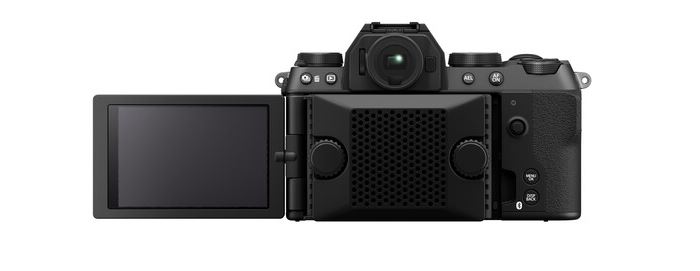
12. VERDICT: Which one Should you buy for the video?
One of the key features of the Fuji camera is its ability to cool down by itself. You can even add an external fan to the camera, which doubles the recording time of the Fuji X-S20. This makes it an ideal choice for recording long podcasts or for wedding cinematography and videography. On the other hand, the Sony A6700 camera has a magnesium alloy body that helps dissipate heat, but it does not have an active cooling mechanism. If you live near the equator and plan to use your camera for longer video recordings, you should be aware of potential overheating issues. However, if you plan to use your camera in an air-conditioned environment, either of these two cameras would be a good choice.
Physical Interface Compared
| Media/Memory Card Slot | Single Slot: SD/SDHC/SDXC (UHS-II) | Single Slot: SD/SDHC/SDXC (UHS-I) [2 TB Maximum] |
| Video I/O | 1 x Micro-HDMI Output | 1 x Micro-HDMI Output |
| Audio I/O | 1 x 1/8″ / 3.5 mm TRS Stereo Headphone Output 1 x 1/8″ / 3.5 mm TRS Stereo Microphone Input |
1 x 1/8″ / 3.5 mm TRS Stereo Microphone Input 1 x 1/8″ / 3.5 mm TRS Stereo Headphone Output |
| Power I/O | 1 x USB-C Input/Output | 1 x USB-C Control/Monitor/Tether |
| Other I/O | 1 x USB-C (Shared with Power Input) | 2.4 GHz Wi-Fi (802.11a/b/g), Wi-Fi 4 (802.11n), Wi-Fi 5 (802.11ac) |
| Mobile App Compatible | Yes: Android & iOS App Name: Creators’ App Functionality: Access Stored Files, Remote Control *As of July, 2023: Check with manufacturer for the most up-to-date compatibility |
Yes: Android & iOS App Name: FUJIFILM XApp Functionality: Access Stored Files, Adjust Settings, Firmware Update, Remote Control, View Live Feed *As of May, 2023: Check with manufacturer for the most up-to-date compatibility |
Camera with Best Display Screen
| Size | 3.0″ | 3″ |
| Resolution | 1,030,000 Dot | 3 x 2 (1,840,000 Dot) |
| Display Type | Articulating Touchscreen LCD | Free-Angle Tilting Touchscreen LCD |
13. Battery Life
When it comes to battery life, the X-S20 has the upper hand over the A6700. While the A6700 can take around 570 photos per charge using the LCD screen and about 550 with the viewfinder, the X-S20 can snap around 750 shots in normal mode and even up to 800 in Economy mode. So, if you’re looking for a camera that can keep up with you on a long day of shooting, the X-S20 might be the way to go.
14. Latest Price
Fuji Film X-S20 – Camera $1299 [Body Only B&H] [Amazon.com] | 15-45mm Lens $1399 [B&H Store] [Amazon.com]
Sony A6700 Camera Latest Price Check here B&H Store,


